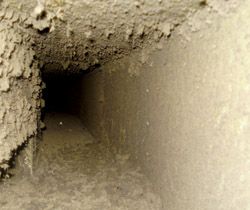Richard Norman, managing director of Indepth Hygiene Services, explains why ductwork should be regularly inspected and cleaned.
Those responsible for the maintenance of building services will be well aware of the Workplace (Health, Safety & Welfare) Regulations which provide an overall framework of legislation requiring that every enclosed workplace is ventilated by a sufficient quantity of fresh or purified air. However, in spite of this legislation, one comes across frequent instances where ventilation systems are clearly not being cleaned. Sooty deposits on ventilation grilles is a common sight in offices and public buildings.
It would seem some of those responsible for the proper maintenance of ventilation are able to ignore this kind of evidence regardless of the regulations.
Why is it important that ventilation systems are cleaned and what evidence is there that uncleaned systems can be a danger to the health of those occupying the areas they ventilate?
Perhaps an answer can be found in the work which has been carried out into the spread of healthcare-associated infections in hospitals.
Dr Ghasson Shabha of Birmingham University has carried out a number of studies on the spread of infections in healthcare premises and maintains that temperature and humidity conditions typically found in ventilation systems provide excellent opportunities for bugs to thrive and to be widely distributed. He has found that dust, which builds up on the internal surfaces of ventilation systems, contains a high proportion of organic compounds including human hair and skin flakes. These act as nutrients for the growth of micro-organisms such as MRSA and C. difficile. As a result of this kind of evidence more hospitals are ensuring ventilation systems are cleaned as part of their battle against the spread of infection.

Kitchen grease poses a fire risk
While ambient conditions might vary between office workspaces and hospital wards it would be difficult to argue similar contamination would not be found in ventilation ducting. In offices they may not support the growth of MRSA and C. difficile but there are other infections which would find conditions in ventilation ducting congenial to development.
Of course, improved filtration materials can play an important role in reducing the levels of contamination. However, experience has shown even where improved filtration materials have been installed in existing systems, the ductwork has rarely been cleaned as part of the upgrading and, therefore, internal duct surfaces invariably remain contaminated.
But it is not only general extract and supply systems which require the attention of those responsible for the welfare and safety of building occupants. In buildings with catering facilities, grease extract ventilation systems are a potential fire hazard and must be regularly cleaned to ensure removal of grease deposits which accumulate in the system ducting. Unlike general ventilation systems, the cleaning of these systems is a legal requirement under the Fire Safety Order, which carries the power to prosecute those failing to comply with its essential requirements.
At a recent seminar, a Fire Authority spokesman stated 'uncleaned grease extract ventilation systems are probably the greatest potential fire risk in buildings with catering facilities'. There is therefore both a 'duty of care' and a legal requirement to have in place a cleaning regime which will ensure the removal of potentially flammable grease deposits which accumulate in the ducting.
Unfortunately there are cleaning contractors who will claim they have cleaned the system when, in fact, they have cleaned only the areas which are easily accessible. Elimination of fire hazardous conditions requires the entire system to be cleaned. A number of restaurant fires in 2009 involving the grease extract ventilation systems provided evidence of inadequate cleaning.
In several cases the inadequacy of cleaning has resulted in insurers disputing claims on the grounds that the systems had not been cleaned according to warranties. So there is a clear warning to those responsible for ensuring compliance with the legislation; be sure your system is cleaned throughout. Blaming the contractor for only partial cleaning will be no defence in the event of prosecution, nor a reason for the insurers to meet the claim.
For facilities and building managers wanting an authoritative guide on the standards to which ventilation systems should be cleaned, the HVCA's publication TR19 gives guidance for the cleaning and maintenance of new build, upgraded and existing ventilation systems. Indepth Hygiene will carry out surveys of systems free of charge to provide management with a reliable and professional assessment of the risk status in both grease extract and general extract and supply systems.
Indepth Hygiene Services, tel: 020 8661 7888 or email
ductclean@indepthhygiene.co.uk.
18 February 2010